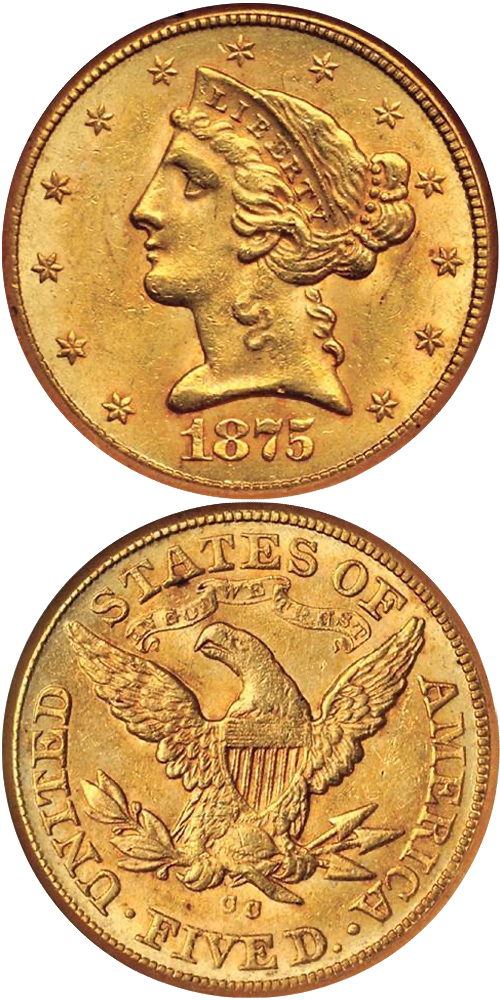1875-CC Liberty Head Half Eagle
Jeff Ambio: At least two different obverse and three different reverse dies have been identified for the 1875-CC Liberty half eagle.
Rusty Goe: With Gold Hill's Crown Point Mine and the Bonanza Firm's Con. Virginia Mine each yielding nearly 500 tons of ore daily, deposits at the Carson Mint flowed in. In mid-April the Nevada State Journal said, "The Carson Mint is running nearly up to full capacity at present on bullion" coming from the major Comstock mines. In July, the Lyon County Times in Dayton, Nev., reported that the government had just contracted to buy $1.5 million in gold and silver bullion from the Con. Virginia.
The coinage of silver would, of course, dominate the work at the Pacific Coast mints during the mid-1870s, but the constant need for gold money would ensure a good portion of each quarter's work schedule would be devoted to making it. Almost half of the government's $1.5 million purchase of bullion in June-August 1875 from the Con. Virginia had consisted of gold.
In the first half of 1875, the Carson City mint produced 8,145 half eagles. The year almost slipped by without the mint adding to that number, but then in December, Coiner Levi Dague, who had replaced William Hy Doane in August, banged out a final run of 3,683 coins. For the second year in a row, the Carson Mint was the nation's leader in half eagle production, despite its low figure of 11,828 pieces.
Even with its typically mushy strike on the center of the reverse, the Battle Born specimen offered here is the second finest known survivor of this date and one of only two Mint State examples extant.
Q. David Bowers: Rusty Goe estimates 150 to 200 1875-CC half eagles exist totally, two being in the Uncirculated category. My estimate is no more than two in Mint State. Again, from any view a Mint State coin is a prime rarity. My estimate for circulated pieces is 90 to 130.
Very Fine is the typical grade for an 1875-CC. At the AU level the variety is very rare. A few turned up in Europe in the late 1980s and early 1990s and were filtered into the market. These were VF to EF and somewhat dull from long-term bank storage. Again the auction record reflects low average quality, but a marvelous exception is Lot 189 in the Thomas Ramsden Collection sale conducted by the Chapman brothers in June 1892: "1875-CC. Uncirculated."
The example to the left was sold by Stack's Bowers Galleries in the 2007 Americana Auction, where it realized $103,500.






